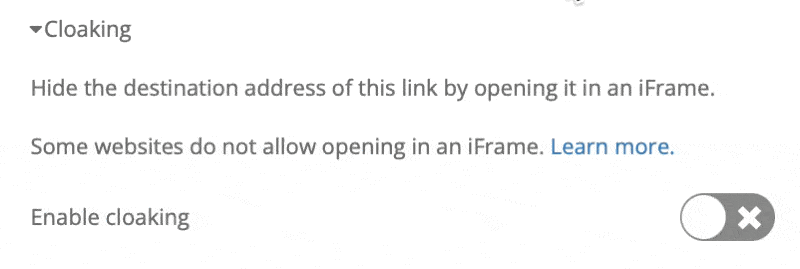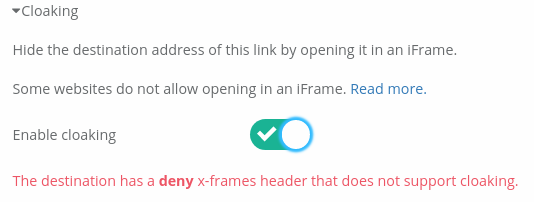Link Disguisers
What is a link disguiser?
A link disguiser, sometimes also called link cloaking, is way of hiding the destination URL from the user clicking the link. You would normally do this to disguise affiliate links from a user. The user will see only pretty URLs, while the underlying destination can have any URL.
How to Create a Disguised Link with Linkly
- Login to Linkly and click Create a New Link. Linkly has a free version with link cloaking enabled, for up to 1000 clicks/month.
- Fill in the Nickname & Destination fields.
- Under Cloaking, flip the cloaking switch.

How Link Disguising Looks to the End User
How Link Disguising Looks to the End User
How link disguisers work
Disguising a link can use one of two methods:
Custom URL shortening
Using an URL shortener like Linkly to produce vanity URLS, like e.g. yourdomain.com/offer.
In this case, the user sees the pretty link, but is redirected to the final destination. If the user checks their address bar, they’ll see the final destination URL.
iFrame link cloaking
Some URL shorteners (including Linkly), have a function that will allow you to cloak a link.
In this case, the destination is opened in an iFrame (effectively a webpage inside another webpage).
The destination URL at the top of the page remains that of the link, and the final destination URL is completely hidden.
Custom URLs & link disguising combined
You can use both custom link shortening and cloaking together, which will create a link like yourdomain.com/offer, which will persist in the address bar, but open a different destination inside the browser window.
Issues with disguised links
Whether a destination website allows itself to be opened in an iFrame is up to the destination. Many large media websites, for example, will prevent themselves being opened in an iFrame.
Many websites now prevent browsers from opening them an iFrame, the technology which enables link disguising to work.
Destination websites can set a meta tag called X-Frame-Option.
When this tag is set to DENY or SAMEORIGIN, browsers are prevented from opening a disguised link.
When using the link cloaking feature in Linkly, Linkly will tell you if the destination is unlikely to work in an iFrame:

If you try to open the link, you'll see the following symbol (Google Chrome):

Sometimes, you'll see the page load, but not the images, for the same reason.
In these cases, you can't use link disguising.
Benefits of Link Disguising
The main reasons to use a link disguiser like Linkly are:
- To hide the use of affiliate URLs/affiliate programs/affiliate IDs from users clicking on links
- To show shortened pretty links, ideally using your own domain name, which increases CTR.
- Allows you to distribute your links as a permalink, and still change the destination URL afterwards, while keeping the short link the same.
- Allows you to add retargeting/remarketing tags to disguised pages, so you can show adverts to users who don't convert.
- All disguised links are also tracking links, so you'll get comprehensive analytics on who clicked your link and when.
Disguised/Cloaked links and Facebook
Sometimes, advertisers will want to use cloaked links in order to advertise on Facebook.
In order to do this, using your own domain with Linkly is required, to create branded short links and get the ads approved.
In cases where ads do not meet Facebook’s guidelines, generally the ads get disabled within 6-24 hours, so use of link cloaking/link disguising is not advised.
Disguised/Cloaked links and Google Ads
Google’s Ad policies require the end destination to be clear to the user when clicking.
Using custom short links or pretty URLs with redirects is permitted on Google Ads.
Using iFrame based cloaking that hides the destination URL fully is not permitted, and will likely result in the ads not being approved.
FAQ's about Link Disguising
How does link disguising work?
Link disguising works by opening the destination page in an iFrame. The URL shown in the address bar is that of the disguising link, and not of the destination.
Can I use a custom domain or vanity URL for my disguised link?
Yes, link disguising works well when combined with a custom domain to create vanity URLs.
Why do some websites not load in iFrames or when disguised?
Not all websites can be opened in iFrames. It's up to the destination website if they block iFrame loading. (Apple's website is a good example of this).
Can you apply Facebook Pixel/Google Tag Manager/retargeting pixels to disguised links?
Yes all re-targeting pixels and scripts and can be used.
Why is my disguised link being blocked or marked as spam?
Link disguising can prevent robots from crawling through a link. This can cause a link to be marked as spam by automated systems. Generally speaking, link disguising is seen as an aggressive tactic and should be restricted to cases where it is necessary.
How are disguised links treated for SEO purposes?
For SEO purposes, iFrames and disguised links are generally considered the same as normal links.
